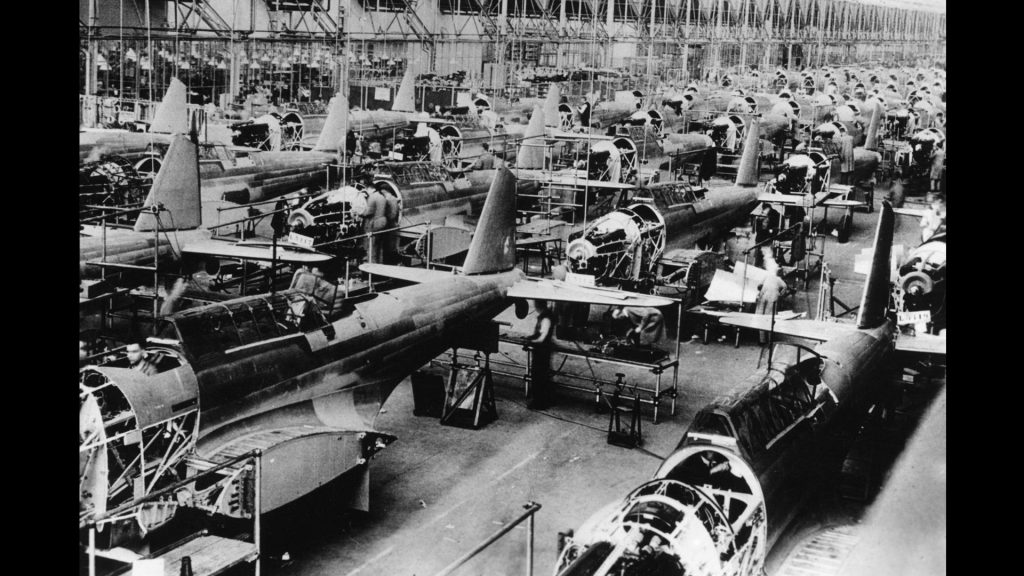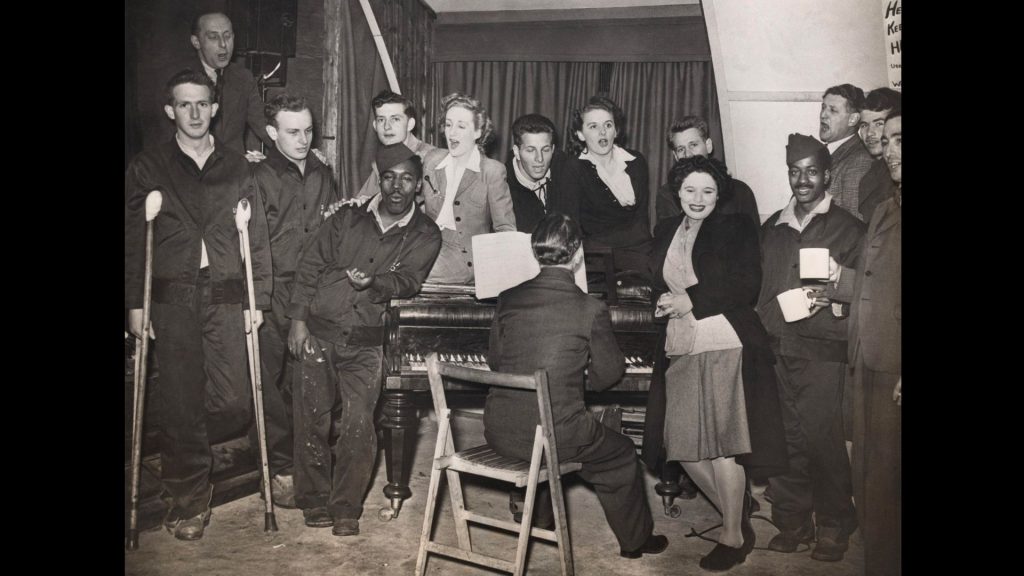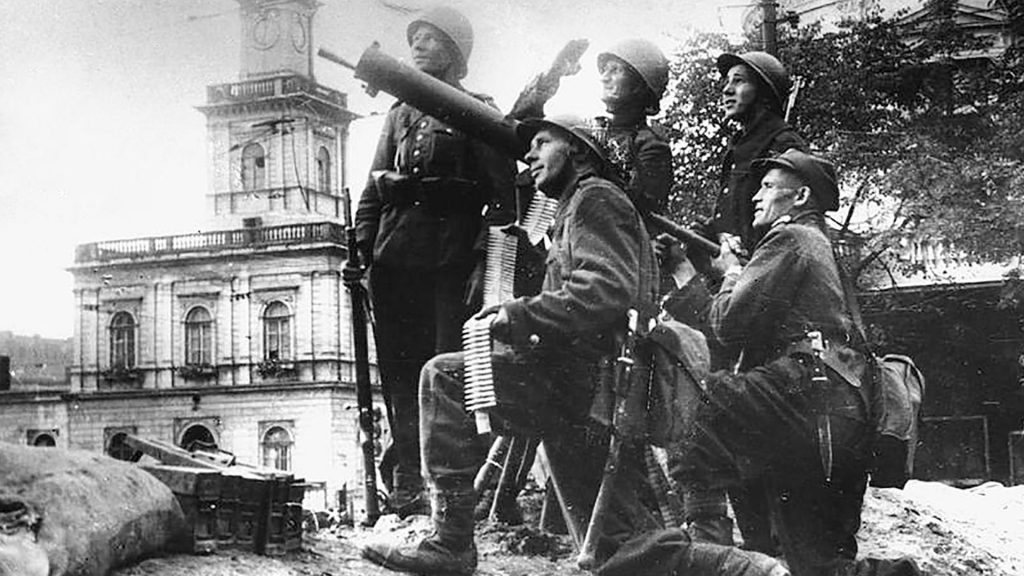Episode 2 History & Images
What was ENSA, the phony war, the Polish resistance? Learn about the real history of World on Fire Episode 2, and discover the amazing family history of World on Fire‘s writer & creator, Peter Bowker, that inspired Lois and Connie’s ENSA storyline!
- 1.
What Was the Phony War?


British aircraft production, part of the mobilization in Great Britain, 1939 In Episode 2 of World on Fire, Harry Chase urges Britain to act, telling his commander, “We abandoned all of Poland, not just Kasia. We haven’t lifted a finger! And all this talking! This diplomacy. What good did it do?”
His frustrations reflect a period from September 1939 to May 1940 known as “the Phony War,” during which Britain and France largely took no major military action after their declaration of war against Germany, aside from a few naval clashes fought at sea. Their strategy was to use the period of inaction to build up their land forces while enforcing a naval blockade of Germany and attempt to exert crippling economic pressure on the enemy. But while French forces waited along the nearly impregnable Maginot Line, their spirits flagging from the enforced passivity, Germany was massively increasing its number of soldiers, and aggressively rearming, manufacturing ammunition and tanks.
At home in Britain, the population quickly prepared for German air raids: conscription and food rationing began, blackouts were compulsory, gasmasks were distributed, and children were evacuated en masse from the cities to the countryside. But as the feared-for raids didn’t materialize, a strange period of difficulty, stalemate, and anti-climax pervaded, leading to the disparaging nickname of “the Phony War.” Other similarly inspired nicknames were coined: the British “Bore War,” the French “Drôle de guerre” (funny or strange war), and even the German “sitzkrieg” (sitting war, the opposite of “blitzkrieg,” lightning war). Yet the German “sitzkrieg” worked to the Nazis’ advantage; not only did they massively rearm during this period, but they also gained the upper psychological hand. As historian Max Hastings describes in his book, Inferno: The World at War, 1939-1945, “[Hitler’s] great advantage was that the Allies had made a principled commitment to confront and defeat Nazism, while lacking any appetite for the bloody initiatives and human sacrifice required to achieve this. Thus, Hitler was left to make his own weather.”
Nicknames aside, the period abruptly ended in the spring of 1940 with Germany’s April invasion of Norway by air and by sea, and their attacks on France, Belgium, the Netherlands, and Luxembourg.
Watch the newsreel “British Forces Prepare for War with Practice Manuoevres” from September 25, 1939.
- 2.
What Was ENSA?


American GIs are entertained by pianist Horatio Davies at a military hospital in West England in 1944, World War 2. ENSA (Entertainments National Service Association) was a traveling entertainment organization that provided troops and war workers with performances of music, plays, and variety acts during World War Two. It was established in 1939 and financed by the NAAFI (Navy, Army and Air Force Institutes), paying a generous wage for the time period: £10 weekly for performers and £4 for the chorus.
ENSA drew from both professional and amateur performers. Because the territory it covered was so vast and its talent pool so…diverse, ENSA was jokingly referred to as “Every Night Something Awful.” Nevertheless, some of the era’s most famous stars performed for the troops with ENSA, including John Gielgud, Vivien Leigh, and Laurence Olivier.
World on Fire writer Peter Bowker drew from his own history in creating Lois’ ENSA storyline. He told MASTERPIECE, “My grandma on my mum’s side was a variety entertainer, and my auntie Anna, the woman I called my aunt when we were growing up, was a British Afro-Caribbean woman who was born in Doncaster in 1912, and they were in a mixed-race musical duo in the 1930s, touring the North of England. They called themselves The Two Shades, and they performed during wartime, and combined their performing with driving ambulances during the Northwest blitz. This has always been such an unusual story in our family history, so that gave me some personal hold on it. And I enjoy the fact that when people challenge the ethnically diverse nature of the cast, I can get out the family photo and say, “Well, how do you explain this?”
- 3.
What Was the Polish Resistance?


Polish soldiers from antiaircraft artillery unit during Siege of Warsaw in September, 1939 Between Germany’s invasion of Poland on September 1 and Warsaw’s surrender on September 27, the city endured a ferocious bombing campaign, artillery barrages, battles, and a brutal siege. As Germany’s air power and armor eroded Warsaw’s defense, the Warszawa Army formed with the mission to defend Warsaw. It was one of many arms of defense—civilians were even asked to build barricades and anti-tank barriers in Warsaw’s streets—and though the siege ultimately forced a surrender after some 10,000 tragic civilian deaths, a number of secret resistance groups had already formed. One such group was “Słuźba Zwycięstwu Polski” (Service for Poland’s Victory), or “SZP.” Formed on the order of Polish Army commander Juliusz Rómmel, SZP continued the fight to liberate Poland. In November 1939, the new Polish Government, in exile in France, created “Związek Walki Zbrojnej” (Union for Armed Combat), or ZWZ) from the SZP, consolidating most of the other resistance groups.
The ZWZ fought the occupation on a number of different fronts: through propaganda, such as the printing of secret bulletins to be distributed among the population; intelligence activities; and sabotage against industry and transportation organizations that furthered the German war effort.
In 1942, the ZWZ was renamed “Armia Krajowa” (Home Army), or “AK,” and became the official armed wing of the Polish Underground State, which was loyal to the Polish government in exile in London.
Watch a newsreel about the surrender of Warsaw from British Movietone (December 31, 1939).
Discover more about World on Fire:
Keep track of all the action with our recap of World on Fire Episode 2.
Hear Cole Porter, Billie Holiday and iconic artists sing the songs of World on Fire in MASTERPIECE’s playlist.
Hear an interview with the actress behind waitress-turned-resistance-fighter Kasia, Zofia Wichłacz, on the MASTERPIECE Studio podcast.




















